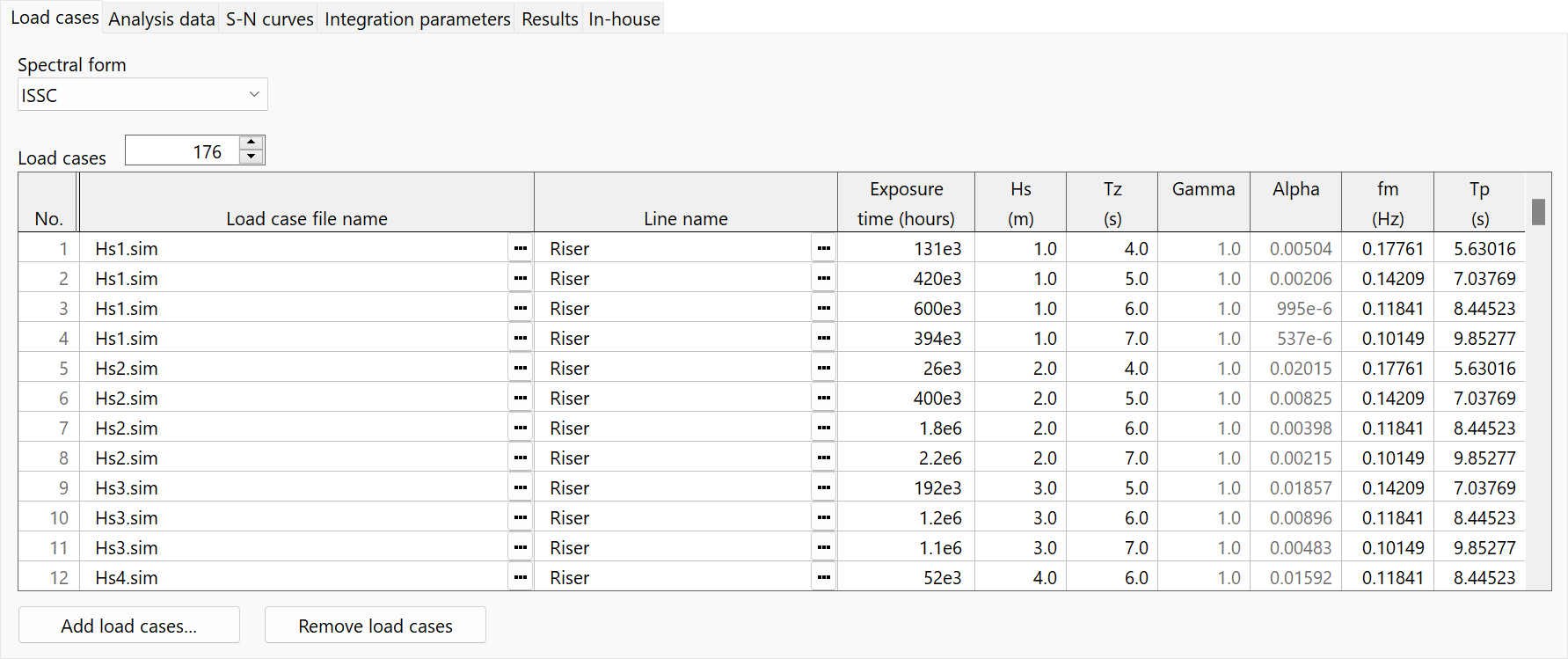
|
Fatigue analysis: Load cases data for spectral analysis |

|
Fatigue analysis: Load cases data for spectral analysis |
The name of the simulation file which represents the load case, either the full path or a relative path.
The name of the line, in the load case simulation file, to be analysed.
| Note: | The line name will usually be the same in all load cases (though this is not necessary). The named lines in the various load cases must, of course, all represent the same physical line and use the same discretisation in the areas being analysed. |
The total time the system is exposed to this load case.
For response RAO spectral analysis, the simulation file name specifies a time domain response calculation or a frequency domain simulation file, from which response RAOs are derived. The spectral fatigue calculation then proceeds by combining these response RAOs with a wave spectrum to produce power spectral density (PSD) functions. This wave spectrum is of the chosen spectral form, which can be one of JONSWAP, ISSC, Ochi-Hubble or Torsethaugen.
The spectral parameters for the chosen spectral form are specified as follows:
When performing a fatigue analysis you will typically have a wave scatter table describing the relative probability of storm occurrence. This determines a number of wave classes, e.g. storms defined by $\Hs, \Tz$ pairs.
The load cases data should be set up to match load cases to wave classes. For example, suppose that you were working with the following (truncated) wave scatter table:
| 4-5 | 9 | 3 | ||||
|---|---|---|---|---|---|---|
| 3-4 | 6 | 18 | 6 | |||
| $\Hs$ | 2-3 | 22 | 132 | 117 | ||
| 1-2 | 3 | 57 | 201 | 249 | ||
| 0-1 | 15 | 48 | 69 | 45 | ||
| 4-5 | 5-6 | 6-7 | 7-8 | |||
| $\Tz$ |
The values in the table represent joint probabilities in parts per thousand, so a value of 201 represents a probability of 0.201.
This wave scatter table gives 16 wave classes and so the fatigue analysis data in OrcaFlex would be set up with 16 corresponding load cases with appropriate pairs of $\Hs$ and $\Tz$ values.
The load case simulation file must support the calculation of response RAOs. The spectral fatigue analysis combines these calculated RAOs with the load case wave spectra (i.e. the $\Hs, \Tz$ pairs) to determine fatigue damage estimates for the load case. To support the calculation of response RAOs the load case simulation file must be one of the following:
With the exception of the wave type data (discussed below), the simulation file should model all aspects of the system and environment that define the load case. For example, you should specify vessel offset, current profile and direction, wave direction etc.
For time domain simulation files, the spectral response analysis method used to calculate the response RAOs naturally captures system nonlinearities such as hydrodynamic drag. For these nonlinear effects to be well-modelled, the choice of $\Hs$ for the response calculation wave is important.
Essentially, the RAOs can be considered as being dependent on wave height. How significant this dependence is will vary from case to case. Certain systems are dominated by linear physical effects, in which case the RAOs may well be independent of wave height. We recommend sensitivity studies to determine the significance of this effect.
In the example above, we might find that the system has significant nonlinearities and so choose to run a response calculation simulation for each row of the wave scatter table. This would give 5 simulation files for $\Hs$ ranges 0-1, 1-2, 2-3, 3-4 and 4-5. There are 4 wave classes corresponding to the 0-1 $\Hs$ range. The load case corresponding to each of these wave classes would then be represented by the same simulation file. The other $\Hs$ ranges are dealt with similarly and so the load cases table would look as below:

| Figure: | Example load cases table |
If the nonlinearities in the system are not so significant, then you may be able to obtain sufficiently accurate results with fewer simulation files, reducing the overall simulation time required. For example, the Hs1, Hs2 and Hs3 simulations could be combined into a single Hs2 simulation etc. Again, the accuracy of such a simplification should be tested with sensitivity studies.
For frequency domain simulation files, the system nonlinearities have been linearised. The process of linearisation again results in the response RAO being dependent on the wave height and, in this case, the other wave type data. Analogous to the time domain case, multiple load cases can be associated with a single simulation file and the number of simulation files needed to accurately represent all the load cases will depend on how significant the nonlinearities are. Sensitivity studies are recommended to confirm that the wave type data in the simulation file well represents all the associated load cases. In the most accurate (but least efficient) scenario, there is a unique frequency domain simulation file for each load case, and for each one the wave type data are consistent with the case's spectral parameters. Here, the linearisation is bespoke for each load case, and the frequency domain spectral analysis is equivalent to conducting a response RAO spectral analysis.
The other decision to make is over the length of the response calculation simulations. You need to simulate for long enough to get accurate results. As for the issue of $\Hs$ discussed above we would recommend using sensitivity studies to determine how long is required.